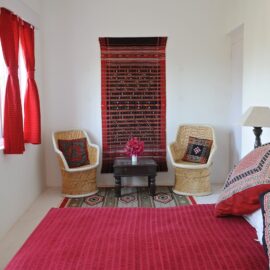Sanjharia, Ajmer Road, Jaipur -302042 INDIA
From
$189.0
Night





A large room on the upper level, the all-white décor – redolent of jasmine – is a counterpoint to the deep copper hues of the four-poster king bed, and traditional Rajasthani furniture. It has a fireplace, windows overlooking tree tops and green fields, and a balcony that hangs over the pool. An excellent choice as a honeymooners’ hideaway.
The fragrant Jasmine that blooms all around the haveli through the summer and drenches Savista with its moist exquisite fragrance ( as if to compensate for the rigours of the dry Rajasthan summer) is the inspiration for this all-white room. The copper coloured bed and cupboard are examples of old-style Rajasthani wood work, while the traditional copper water canteens standing on the cupboard-top remind us that drinking water stored in copper containers is considered healthy in the Indian ayurvedic (indigenous system of medicine) tradition.
Jasmines are found in the tropical and subtropical areas of Africa, Asia and Australasia. They display the greatest diversity of species in south and southeast Asia, where there are about 200 species of jasmine and only one is native to Europe. The Jasmine (genus Jasminum) belongs to the olive family (Oleaceae). The name is derived from the Persian Yasmeen (“gift from God”), through Arabic and Latin, and its hallmark is its pure white beauty and unique fragrance. This beloved and fragrant flower is known in Hindi by the charming names chameli and mogra, and in the rich tapestry of southern Indian languages, it is affectionately called malli. Typically, the buds get formed in the heat of the day and the petals open up in the cool of the late evening and night. The Jasmine blooms in greater profusion during the waxing phase of the moon.
Across the Oriental world, the Jasmine is revered for its many symbolisms. In India, it is associated with the spiritual quest and divine hope, and is used extensively in worship and marriage and other rituals. It is grown in home gardens, sold by the weight in the market, and in the summer months you will also see women sitting by the roadside weaving it into garlands for the consumer on the run. Women in South and South East Asia routinely wear it in their hair and offer Jasmine garlands as gifts to women visitors to the home.
Pakistan, Indonesia and the Philippines all honour the Jasmine as their national flower. In Thailand, it is the symbol of the pure and unconditional love associated with motherhood. In China, it symbolises love, sensuality and attachment, amiability, nobility, grace and elegance. In Syria, it is the symbolic flower of Damascus which is called the “City of Jasmine”.
In these countries Jasmine is also used in many other ways. Jasmine essential oil is produced in India, Egypt, China and Morocco. In aromatherapy it is used as an anti-depressant and to promote relaxation. The scent is used in incenses and massage oils. Some cultures believe that when Jasmine is burned or worn it will attract wealth, spiritual peace and prophetic dreams. The drinking of Jasmine tea is believed to prevent cancer. In the Indian ayurvedic tradition, the Jasmine flower is believed to have medicinal uses and is used to treat medicinal worms, ulcers, boils, skin diseases and eye disorders.
Check-in/check-out: 12 noon.
For availability and reservations, please write directly to [email protected].
Main features:
Stunning, uniquely-designed, airy rooms with plenty of natural light and views of greenery all around.
Carefully selected handmade / restored Rajasthani furniture and artifacts, or a blend of traditional and modern furniture.
Very comfortable beds for the best possible sleep.
Restored colonial / traditional Indian / contemporary writing desk in most rooms.
Every room has either a sun terrace, or an additional glass-enclosed sitting room / patio with gorgeous views of the outdoors, or an attached balcony overlooking the pool. A few have fireplaces.
Room and bathroom windows can be opened to let in fresh air when preferred.
All bathrooms are ensuite, have hot and cold running water and rain showers, and views of tree-tops.
Facilities:
- Complimentary breakfast;
-
Tea / Coffee making facility;
-
Pure, natural drinking water from Savista’s borewells (complimentary bottled water on request);
-
Complimentary nibbles;
- Free wireless internet;
- Air conditioning;
- Space heating in chilly weather;
- Sumptuous duvet and high quality cotton bed linen;
- Hundred percent cotton towels, robes and room slippers;
- Branded herbal bath products.
Other Facilities:
- Business services (scanning, copying, printing);
- Laundry and ironing*;
- Hair dryer;
- Concierge service;
- Maps and travel guides;
- Medicines, germicide gargle, sewing accessories etc. (an “Ask For” menu is placed in each room. If you require some other service that is not listed, please ask and we will try our best to arrange it for you);
- Doctor/dentist appointments and facilitation;
- For guests with physical disabilities, one room can be outfitted to suit their needs. Please let us know when booking.
(* chargeable)
N.B.
Most rooms feature a large double bed (king-size), and are for single/double occupancy;
Five rooms can be adapted into twin-bedded rooms (please let us know when you are specifically looking for a twin room;
A child below 4 stays free if sharing the parents’ bed;
Children of 4 and above require an extra bed. Four of our rooms can accommodate an extra rollaway bed (for a child only) for a small extra charge. Please email us with your requirement and we will help you make your selection;
All our guest rooms are non-smoking;
We are a pet-free property;
We do not have T.V.s or intercoms in the rooms;
We accept Visa and Master credit cards, Bank to bank transfers and cash payments (we do not accept Amex cards).
No hidden costs: No resort fees and other vague charges; No workout charges; No towel replacement costs; No wi-fi costs; No parking fees; No breakfast bills.
Be the first to review “Jasmine”
You must be logged in to post a comment.
Regular plan
| Mon | Tue | Wed | Thu | Fri | Sat | Sun |
|---|---|---|---|---|---|---|
| $189.0 | $189.0 | $189.0 | $189.0 | $189.0 | $189.0 | $189.0 |


Reviews
There are no reviews yet.